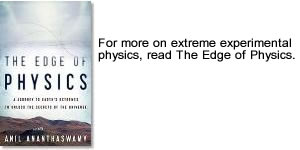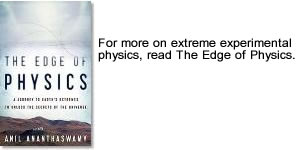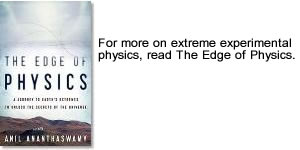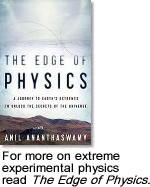Posts from — May 2011
Einstein Goes Underground

Credit: NASA
EUROPEAN PHYSICISTS want to go underground to build a sensitive observatory capable of detecting gravitational waves that are thought be generated when black holes merge. The “Einstein Observatory” will 100 times more sensitive than existing detectors, and will likely be able to detect gravitational waves generated just after the Big Bang.
Gravitational waves are ripples in the fabric of spacetime and are predicted by Einstein’s General Relativity. The basic idea behind the detection of such waves is pretty simple. Build two extremely long tunnels and bounce lasers back and forth in these tunnels, which can each be a few kilometres long. A passing gravitational wave will distort spacetime and hence change the lengths of these tunnels ever-so-slightly. If the tunnels are at right angles, then they will distort differently, and consequently the lasers will have to travel different lengths. The interference pattern generated by the interaction of the lasers can reveal the passage of a gravitational wave.
Of course, building such a detector to “see” extremely faint movements of spacetime is another matter altogether. The first generation of gravitational wave detectors, such as VIRGO and LIGO have not seen any such wave, but have set limits on what physicists can expect in terms of the frequency and intensity of gravitational waves from cosmic collisions of black holes, for instance.
Already, the next generation of detectors, such as Advanced LIGO, are being built, and physicists hope to detect the first waves with these better machines.
The biggest hindrance to building sensitive gravitational wave detectors is noise, which can create a stochastic background against which it is very difficult to detect real waves.
The Einstein Observatory plans to reduce such noise, especially seismic noise, by going about 100-200 metres underground. The design calls for 3 interferometers, each tuned to different frequencies of gravitational waves, and each with interferometer arms about 10 kilometres long.
If such an instrument does get built, it’ll make gravitational wave astronomy as routine as other forms of astronomy (such as optical and radio).
Here’s the press release from interactions.org
May 19, 2023 No Comments
Super flares in the Crab nebula
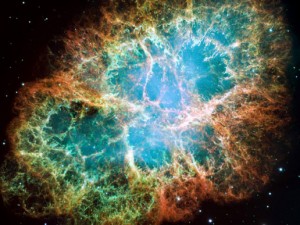
NASA’s FERMI gamma-ray space telescope has recorded the most violent outbursts from the Crab Nebula supernova remnant ever seen.
In the year 1054, light from a star that exploded about 6,500 years earlier reached Earth. Modern telescopes have given us an astounding view of the supernova remnant, in the form of the Crab Nebula. At the heart of the nebula is a neutron star that is rotating 30 times per second, sending periodic pulses of radiation towards Earth. The nebula is also a constant source of gamma-rays.
On April 12, FERMI detected gamma-ray flares that were 30 times more powerful than the average emissions from the nebula. Physicists think that a phenomenon called magnetic reconnection-in which the magnetic field lines near the neutron star cross and realign, leading to a release of extraordinary amounts of energy-is accelerating electrons to high energies. These electrons are then interacting with the magnetic field and emitting gamma-rays, which is what FERMI detected.
The most amazing fact that stands out from these observations is this: the region that is emitting these gamma rays is about the size of our solar system!
For more about these flares, see NASA’s press release.
May 16, 2023 No Comments
The Stunning Lagoon Nebula
THE GEMINI OBSERVATORY released a stunning photograph of the Lagoon Nebula, a stellar nursery about 5,000 light years away, which, if you may, puts in our own galactic neighbourhood.
Argentinean astronomers Julia Arias and Rodolfo Barbá captured the image using the Gemini South telescope atop Cerro Panchon in the Chilean Andes.
The photograph is a composite of images taken using different filters, some of them collecting light that would not be visible to the naked eye. So, if you were to look at the Lagoon Nebula using a small telescope, it would appear rather different. But you can find it using an amateur telescope, if you trained it in the direction of Sagittarius in the southern sky.
Here’s a link to a high-res JPEG.
More details can be found on the Gemini Observatory website.
May 5, 2023 No Comments
Gravity Probe B confirms Einstein’s Theories
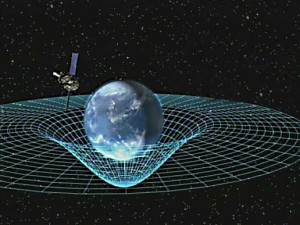
IT TOOK FIVE DECADES from conception to results, but finally NASA’s Gravity Probe B has confirmed two cherished predictions of Einstein’s General Theory of Relativity.
“It is wonderful to have completed this landmark experiment testing Einstein’s universe. Einstein survives!” said Professor Francis Everitt of Stanford University, principal investigator of Gravity Probe B.
Not that Einstein’s theory was in any real danger of being proven wrong in the local environment of the Earth, nonetheless this long-awaited confirmation is worth celebrating.
Gravity Probe B used impeccably-designed gyroscopes to put Einstein to the test. Newton’s theory of gravity predicts that the axis of a gyroscope spinning freely in space, without any other forces to disturb its motion, would continue pointing in the same direction forever. Einstein begged to differ. His theory predicts that the fabric of spacetime around Earth is being warped by Earth itself (the geodetic effect), plus the rotating Earth is also dragging along spactime (the frame dragging effect), both of which would perceptibly change the direction of a gyroscope.
Both effects have been tested and confirmed by Gravity Probe B. Now, those interested in testing Einstein’s General Relativity will likely set their sights on large-scale phenomena (which occur on cosmological scales) and begin testing them with increasing accuracy.
For more information see:
Lockheed Martin Press Release
NASA Press Release
May 4, 2023 No Comments

